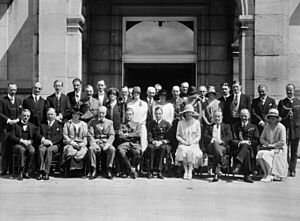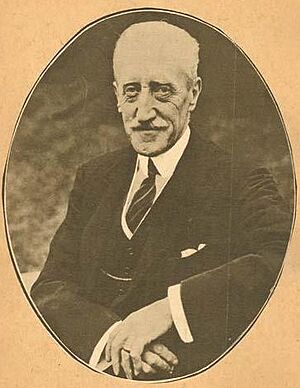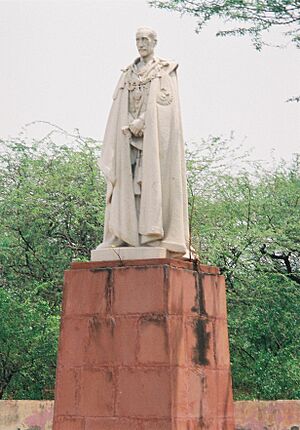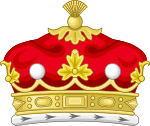Freeman Freeman-Thomas, 1st Marquess of Willingdon facts for kids
Quick facts for kids
His Excellency The Most Honourable
The Marquess of Willingdon
|
|
|---|---|
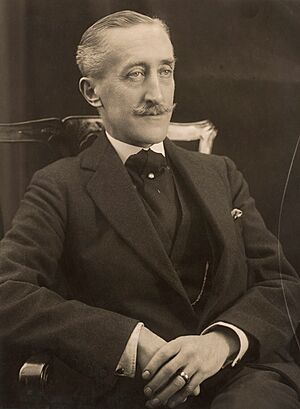 |
|
| Viceroy and Governor-General of India | |
| In office 18 April 1931 – 18 April 1936 |
|
| Monarch | George V Edward VIII |
| Prime Minister | Ramsay MacDonald Stanley Baldwin |
| Preceded by | The Lord Irwin |
| Succeeded by | The Marquess of Linlithgow |
| 13th Governor General of Canada | |
| In office 5 August 1926 – 4 April 1931 |
|
| Monarch | George V |
| Prime Minister | Canadian • W. L. M. King • R. B. Bennett British • Stanley Baldwin • Ramsay MacDonald |
| Preceded by | The Viscount Byng of Vimy |
| Succeeded by | The Earl of Bessborough |
| More... | |
| Personal details | |
| Born | 12 September 1866 Eastbourne, East Sussex, England |
| Died | 12 August 1941 (aged 74) Ebury Street, Westminster, London, England |
| Spouse |
Marie Adelaide Brassey
(m. 1892) |
| Education | Eton College |
| Alma mater | Trinity College, Cambridge |
| Profession | Politician |
Freeman Freeman-Thomas, 1st Marquess of Willingdon (born September 12, 1866 – died August 12, 1941) was an important British politician and leader. He held two very big jobs: he was the Governor General of Canada and later the Viceroy and Governor-General of India. These roles meant he represented the British King in these countries.
Freeman-Thomas was born in England. He went to famous schools like Eton College and the University of Cambridge. For 15 years, he served in the Sussex Artillery, a military group. Later, he worked in politics and diplomacy. He became an assistant to his father-in-law, who was a governor in Australia. In 1900, he was elected to the British Parliament. He held many government jobs, including helping the British Prime Minister. He was later given the title Lord Willingdon. From 1913, he served as a governor in different parts of the British Empire. He was Governor of Bombay and then Madras in India. In 1926, he became the Governor General of Canada. After that, in 1931, he became the Viceroy and Governor-General of India. He held this important position until 1936. After his time as Viceroy, he received another high honor and was made the Marquess of Willingdon. He passed away in London in 1941.
Contents
Early Life and School Days
Freeman Thomas was the only son of Freeman Frederick Thomas and Mabel Brand. His father was an officer in the rifle brigade. Sadly, his father died before he was two years old. His mother raised him and sent him to Eton College, a well-known school.
At Eton, he was the head of the Eton Society. He also played on the school's cricket team for three years and was captain in his last year. He loved sports and continued playing cricket at the University of Cambridge. He played for Trinity College, and also for the Sussex and I Zingari cricket clubs. After university, he joined the Sussex Artillery for 15 years, becoming a major.
Family and First Steps in Politics
In 1892, Freeman-Thomas added "Freeman" to his last name. He married Marie Brassey, whose father was Lord Brassey. Freeman-Thomas often said his wife was a great support to him. They had two sons: Gerard, born in 1893, and Inigo, born in 1899. Sadly, Gerard died in World War I in 1914. Inigo later inherited his father's title.
In 1897, Freeman-Thomas became an assistant to his father-in-law, who was the Governor of Victoria, Australia. When he returned to the United Kingdom, he joined the Liberal Party. In 1900, he was elected to the British Parliament for Hastings. He then worked in the government from 1905 to 1906. Even though he lost the 1906 election, he soon returned to Parliament. For a time, he was a secretary to the Prime Minister, H. H. Asquith. In 1910, he was given the title Baron Willingdon. The next year, he became a special assistant to King George V and was a favorite tennis partner of the King.
Governor of Bombay: Helping India
On February 17, 1913, Willingdon became the Crown Governor of Bombay in India. To mark this, he was given a special honor called the Knight Grand Commander of the Order of the Indian Empire. A year later, World War I began. India, as part of the British Empire, joined the war. Lord Willingdon helped by taking care of wounded soldiers from the war.
During this time, Mahatma Gandhi returned to Bombay from South Africa. Willingdon was one of the first people to welcome him. He invited Gandhi to Government House for a meeting. Willingdon later described Gandhi as "honest, but a revolutionary and very dangerous."
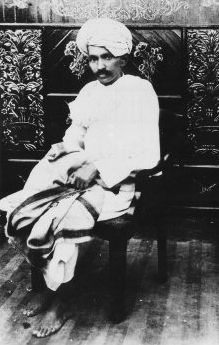
In 1917, a severe famine hit the Kheda region of Bombay. Farmers could not pay their taxes. But the government insisted on collecting taxes and even increased them by 23%. Kheda became the place for Gandhi's first non-violent protest, called satyagraha, in India. With help from others, Gandhi organized people to ask Willingdon to cancel the taxes. The government refused and began taking property by force. Gandhi then led a non-violent resistance. This protest eventually succeeded and made Gandhi famous. For his work in governing and helping with the war, King George V gave Willingdon another honor in 1918.
Governor of Madras: Challenges and Changes
After a short time back in the United Kingdom, Willingdon was appointed Governor of Madras on April 10, 1919. This happened after new rules were made to share power in India between the government and lawmakers. In November 1920, Willingdon called for the first election for the Madras Legislative Council. However, the Indian National Congress party, following Gandhi's non-cooperation movement, refused to participate. So, the Justice Party won the election easily. Willingdon appointed A. Subbarayalu Reddiar as the leader of the government.
The next year, in August 1921, Willingdon faced serious riots in the Malabar District. After many cases of burning, stealing, and attacks, Willingdon declared martial law. This meant the military took control to stop the riots. Around the same time, over 10,000 workers in Chennai went on strike for six months. This also led to riots between workers who supported and opposed the strike. Police had to step in to stop these riots too.
When he returned to the United Kingdom after his time as Governor of Madras, Willingdon was given a higher title. On June 24, 1924, he became Viscount Willingdon.
Governor General of Canada: A New Role
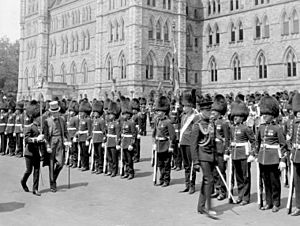
On August 5, 1926, King George V chose Willingdon to be his representative in Canada. This was a very important job. The King himself suggested Willingdon for the role. The Canadian Prime Minister, William Lyon Mackenzie King, also preferred Willingdon. Willingdon was told about his new job while he was on a trip in China.
This was the last time the British King appointed a Governor General for Canada based on advice from the British government. After an important meeting in October 1926, it was decided that countries like Canada would be equal to Britain. The King would act on the advice of that country's own leaders. This idea became official in 1931.
Also, in 1928, the Governor General stopped being the main diplomatic link between Britain and Canada. Britain appointed its own special representative to Canada.
Willingdon arrived in Canada in late 1926. On October 2, he officially became Governor General in Quebec City. He then traveled to Ottawa to live in Rideau Hall, the official home for the King's representative. This was just one of many trips he took across Canada. He met many Canadians and brought a "sense of humor and an air of informality" to his duties. He was the first Governor General to travel by plane, flying between Ottawa and Montreal. He was also the first to make official visits to other countries. He toured the Caribbean in 1929 and visited the United States in 1927. There, he met President Calvin Coolidge.
In Canada, Willingdon welcomed members of the Royal Family. This included the King's two sons, Prince Edward and Prince George. They came to Canada for the 60th anniversary of Canadian Confederation. The princes stayed at Rideau Hall. Prince Edward, with Willingdon, dedicated the altar and carillon at the Peace Tower. The first playing of the carillon was heard across Canada on the first ever coast-to-coast radio broadcast. This marked the completion of the Centre Block of Parliament Hill. The next year, Willingdon moved the annual New Year's party to this new building. A few months before leaving Canada, Willingdon received another higher title. On February 23, 1931, he became the Earl of Willingdon and Viscount Ratendone.
The Earl and Countess of Willingdon loved the arts. They started the Willingdon Arts Competition for painting and sculpture. They also left a collection of carpets and art from their travels in India and China at Rideau Hall. Willingdon also loved sports like fishing, tennis, skating, skiing, curling, cricket, and golf. In 1927, he donated the Willingdon Cup for Canadian amateur golf, which is still played every year.
Willingdon often watched home games of the Ottawa Senators hockey team. In 1930, he gave a trophy to be awarded to the Senators player who helped his team the most.
Viceroy and Governor-General of India: Return to Leadership
After five years as Governor General of Canada, Willingdon was asked to return to India as its Viceroy and Governor-General. He officially took this role on April 18, 1931, just two weeks after leaving Canada. When Willingdon arrived in India, the country was facing hard economic times due to the Great Depression. India sent a lot of gold to the United Kingdom during this period.
At the same time, Willingdon had to deal with the independence movements led by Mahatma Gandhi. The British government told Willingdon to only work with Indians who supported British rule. This did not include Jawaharlal Nehru and the Indian National Congress party, which started a Civil Disobedience Movement on January 4, 1932. Willingdon took strong action. He put Gandhi in prison. He also made the Congress party illegal and arrested many of its leaders and members. In total, he imprisoned 80,000 Indian activists. Without their leaders, the protests became less organized. Gandhi stayed in prison until 1933.
Willingdon also started important building projects. He ordered the construction of the Sukkur Barrage across the Indus River. This project cost a lot of money but provided jobs and brought water to millions of acres of land in the Thar Desert. He also built the Willingdon Airfield (now Safdarjung Airport) in Delhi. One day, he was not allowed into a club because he was with Indian friends. This made him create the Willingdon Sports Club in Bombay, which allowed both Indians and British people to join. This club is still open today.
Just like in Canada, Willingdon was the Chief Scout for the Bharat Scouts and Guides in India. He believed Scouting would greatly help India and promoted it, especially in villages.
Later Life and Legacy
After returning to the United Kingdom, Willingdon received more honors from King George V. He was appointed the Lord Warden of the Cinque Ports, a very high honor. He was also given an even higher title, becoming Marquess of Willingdon on May 26, 1936. He was the most recent person to receive this rank.
Willingdon continued to be involved in international affairs. He went on a goodwill trip to South America and represented the United Kingdom at celebrations in New Zealand in 1940. The next year, on August 12, 1941, the Marquess of Willingdon passed away in London. His ashes were placed in Westminster Abbey, a very famous church.
Honours
| Viceregal styles of the Viscount Willingdon (1926–1931) then the Earl of Willingdon (1931–1936) |
|
|---|---|
| [[File: |
|
| Reference style | His Excellency The Right Honourable (in Canada, also) Son Excellence le très honorable |
| Spoken style | Your Excellency (in Canada, also) Votre Excellence |
- Appointments
 July 18, 1911 – January 31, 1913: Lord-in-Waiting to His Majesty the King (a special assistant to the King)
July 18, 1911 – January 31, 1913: Lord-in-Waiting to His Majesty the King (a special assistant to the King) March 12, 1913 – July 21, 1941: Knight Grand Commander of the Most Eminent Order of the Indian Empire (GCIE)
March 12, 1913 – July 21, 1941: Knight Grand Commander of the Most Eminent Order of the Indian Empire (GCIE) June 3, 1918 – July 21, 1941: Knight Grand Commander of the Most Exalted Order of the Star of India (GCSI)
June 3, 1918 – July 21, 1941: Knight Grand Commander of the Most Exalted Order of the Star of India (GCSI) July 20, 1926 – July 21, 1941: Knight Grand Cross of the Most Distinguished Order of Saint Michael and Saint George (GCMG)
July 20, 1926 – July 21, 1941: Knight Grand Cross of the Most Distinguished Order of Saint Michael and Saint George (GCMG) August 5, 1926 – April 4, 1931: Chief Scout for Canada
August 5, 1926 – April 4, 1931: Chief Scout for Canada August 5, 1926 – April 4, 1931: Honorary Member of the Royal Military College of Canada Club
August 5, 1926 – April 4, 1931: Honorary Member of the Royal Military College of Canada Club March 20, 1931 – July 21, 1941: Member of His Majesty's Most Honourable Privy Council (PC)
March 20, 1931 – July 21, 1941: Member of His Majesty's Most Honourable Privy Council (PC) December 4, 1917 – July 21, 1941: Knight Grand Cross of the Most Excellent Order of the British Empire (GBE)
December 4, 1917 – July 21, 1941: Knight Grand Cross of the Most Excellent Order of the British Empire (GBE)
- Medals
 1902: King Edward VII Coronation Medal
1902: King Edward VII Coronation Medal 1911: King George V Coronation Medal
1911: King George V Coronation Medal 1935: King George V Silver Jubilee Medal
1935: King George V Silver Jubilee Medal 1937: King George VI Coronation Medal
1937: King George VI Coronation Medal
Honorary Military Appointments
 August 5, 1926 – April 4, 1931: Colonel of the Governor General's Horse Guards
August 5, 1926 – April 4, 1931: Colonel of the Governor General's Horse Guards August 5, 1926 – April 4, 1931: Colonel of the Governor General's Foot Guards
August 5, 1926 – April 4, 1931: Colonel of the Governor General's Foot Guards August 5, 1926 – April 4, 1931: Colonel of the Canadian Grenadier Guards
August 5, 1926 – April 4, 1931: Colonel of the Canadian Grenadier Guards 1936 – July 21, 1941: Colonel of the 5th battalion of the Royal Sussex Regiment
1936 – July 21, 1941: Colonel of the 5th battalion of the Royal Sussex Regiment
Places and Awards Named After Him
- Awards
- Organizations
- Geographic Locations
 Alberta: Mount Willingdon
Alberta: Mount Willingdon Alberta: Willingdon (a town)
Alberta: Willingdon (a town) British Columbia: Willingdon Avenue, Burnaby
British Columbia: Willingdon Avenue, Burnaby British Columbia: Willingdon Heights, Burnaby
British Columbia: Willingdon Heights, Burnaby India: Willingdon Dam, Junagadh
India: Willingdon Dam, Junagadh India: Willingdon Airport, New Delhi (later renamed Safdarjung Airport)
India: Willingdon Airport, New Delhi (later renamed Safdarjung Airport) India: IAF Willingdon, New Delhi
India: IAF Willingdon, New Delhi India: Willingdon Island
India: Willingdon Island
- Schools
 British Columbia: Willingdon Secondary School, Burnaby
British Columbia: Willingdon Secondary School, Burnaby India: Willingdon College, Sangli
India: Willingdon College, Sangli Quebec: Willingdon Elementary School, Montreal
Quebec: Willingdon Elementary School, Montreal
Coat of Arms
|
See also
- List of alumni of Trinity College, Cambridge



